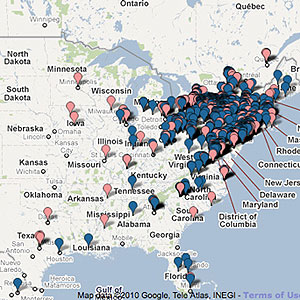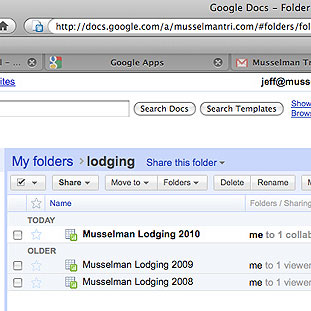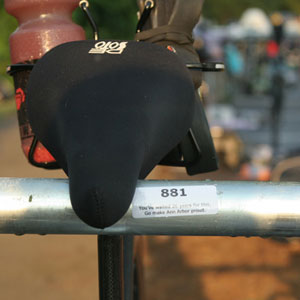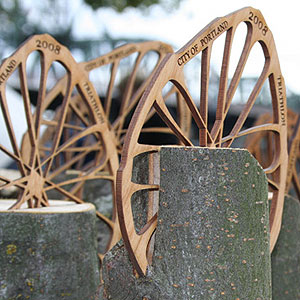On Technology

I was educated as a computer science engineer. I spent long nights in the depths of Princeton's Engineering Quadrangle searching for misplaced semicolons and fussing over finicky EPROMs. I can describe the P = NP problem and tell you which Motorola 6502 assembly instructions will make a model train go puffing over a cantilevered bridge.
Thank the Good Lord I am now a race director.
That does not mean I've left the world of computers behind. Technology plays a fundamental role in my daily work, stitching together design and beauty and freeing myself from tedious tasks in favor of those more intriguing. In many ways, the promise of the information age—more leisure time than you know what to do with—has not been realized, as we seem to have infinite capacity for distracting ourselves. But with a little discipline you, too, can spend the afternoon in the garden when once you sat tethered to the cathode ray tube.
This article will get a little technical. I invite non-techies to read anyway, as I'll try to make it entertaining (flowcharts are fun!). For the bits & bytes crowd, though, I'd like to describe a pathway to fulfilling the geek mantra: "Set It and Forget It."
Being a race director is the perfect vocation for a computer scientist—I kid you not. From registration and mapping to logistics and scheduling, there are myriad ways to make life easier and less complex. I used to maintain a dedicated server housed somewhere in central Florida, a computer I've never seen much less tapped at its keyboard. Through the miracles of linux and SSH I administered a web server, email server, and a couple other applications to accomplish my race directing needs.
From the outset, I didn't like existing registration systems—they were too costly, ugly, or ad-saturated for the type of experience I wanted my participants to have—so I created my own, in 2004. Over the years it's evolved and expanded to keep pace with my laziness; it now creates swim waves automagically, facilitates athlete carpools, plots participants on a real-time map (sponsors like that), and reduces our carbon footprint by allowing athletes to offset the greenhouse gasses produced through travel.
When I needed to create a new bike course for Musselman, I realized that driving and/or biking all possible roads in Seneca County would not be my preferred way of spending the weekend. Happily, Google Maps and its programmable API had recently arrived on the Information Superhighway, and the armchair race director was born. Now I could cruise around the world with my mouse, investigating roads and parks and rivers with the flick of a wrist. The basic Google implementation provided a scaffolding, but a system didn't exist for plotting the swim, bike, and run on the same map, so I invented my own. And with the marriage of elevation data from the U.S. Geological Survey, instant elevation profiles could be created as well.

The mapping software made it possible to design the Portland Triathlon courses without swimming, riding, or running the routes once. (Point of fact: you can't ride the bike course any time other than raceday, as it travels against the normal traffic flow through a tunnel that has no shoulder.) As a happy bonus, the mapping system also lets me quickly create
The dedicated server I previously mentioned was described in the past tense for a reason—it's become obsolete. Over the past five years, one company seems to have taken occasional peeks at my technology wish list and implemented nearly all of them. In what might be a cunning Pinky & The Brain quest to take over the world, Google has developed a variety of services that I can latch onto: Google now hosts all of our event spreadsheets in the form of Google Docs; it manages email and shared calendars for all three races through Google Apps; it dredges webserver logs to guide my website layouts; it even runs the mapping system. "Google Apps Engine" employs what's called "in the cloud" computing to make the interactive maps available from 450,000 Google computers around the world.
All for free.
Take a moment to consider what I'm saying. I don't pay a penny for email hosting, collaboration tools, website analytics, or use of the most robust server network in the world. I don't own Google stock, and I'm not being paid to be their spokesperson. But I do know services that will make my life easier, and my expenses less, when I see them.
Technology can be intimidating. It can be cold and impersonal, a soulless machine droning monotonously in a dark corner. But it doesn't have to be. Three years ago, with the help of tools already in place, I decided to customize the bike racks at Musselman. The idea was to transform a fairly innocuous part of the event into something meaningful. Since bike racks are one of the first (and last) things an athlete sees, they carry the potential to set the tone for the entire event, as well as leave a lasting impression.

It's a straightforward thing to do. An export from the registration system produced a spreadsheet that could be used to produce labels. Typically, bib numbers are the only ink that appears on bike rack labels—but why not include more? We're more than a number, after all. A "mail merge" made all the athlete's information available to the label, so I inserted each participant's city into a message that read, "Make Baltimore proud today."—with the appropriate city filled in.
A new message greeted participants the following year, but you'll have to attend Musselman to see what it said.
The effort was worth it. I heard folks talking about the message as they came upon their place on the racks, and instead of nerves they felt part of something bigger. Instantly their hometown was part of the journey. One lady broke down and started crying (maybe that's not the best way to start the day!). Later I received emails mentioning the message; people remembered the greeting well beyond raceday. As part of a holistic effort to create a personal, meaningful, family-focused event, this small piece instilled a positive feeling within each competitor—and that carried over to the entire experience.
If you're a race director, there are a couple simple things you can do to eliminate huge line items in your yearly budget. Understand the difference between raster and vector images. Find your way around Photoshop. Learn how to build a website. And probe Google's services for better ways to do what you already do… for free.
There are things that Google will never be able to do. It can't build a bike rack or share stories at a post-race BBQ. It can't reassure a beginner or teach a child to swim. I'll be the first to admit that the Always-On generation has its shortcomings. But used intelligently, deliberately, and creatively, technology can help turn a frazzled race director into a bedazzling race director.
Series installments:
On Design
On Beauty
On Technology
On Disaster
On Liveability
On Stories
On Innovation
On People
On Community
On Fun




Start the discussion at slowtwitch.northend.network